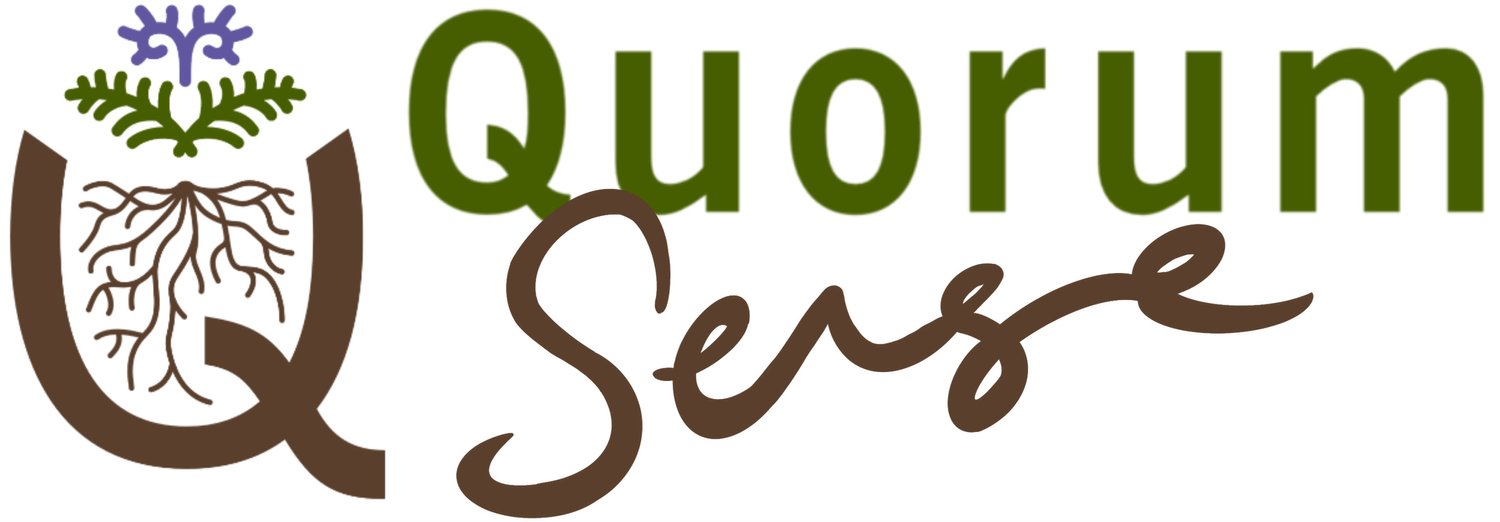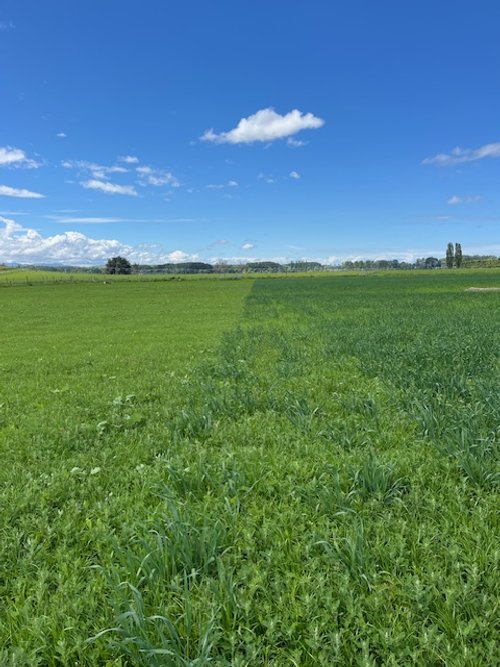Catch the Rain: Trialing methods to restore soil health
James Pearse and Brittany Talbot farm a 160ha property co-owned with James’ parents in Totara Valley, near Pleasant Point, New Zealand. Brittany works off farm as a local agronomist and brings different knowledge, experience and perspective to the farm.
Catch the Rain is a farmer education, research and innovation project focused on improving rainfall infiltration and soil moisture retention on non-irrigated pastoral farms.
James Pearse and Brittany Talbot farm a 160ha property co-owned with James’ parents in Totara Valley, near Pleasant Point, New Zealand. Brittany works off farm as a local agronomist and brings different knowledge, experience and perspective to the farm.
The farm is 60% irrigated and operates a mixed system with velvet stags and finishing cattle. Three years ago, they also took on an 80ha organic lease block nearby, allowing for additional grazing and winter feeding. While the lease farm has been organic for 30 years, they are no longer certified but continue to maintain organic practices.
The home farm operates intensively with rotational grazing, winter feed crops, and balage supplements. By contrast, the lease block is low-input, with grass, hay and balage used for winter feed, and no winter crops or regrassing.
A clear demonstration between seed mix one on the left, and seed mix two on the right (details below).
‘Catch the Rain’ project
James and Brittany joined the Catch the Rain (CtR) project to explore ways to improve soil structure and pasture performance after winter cropping. Their main interest is how to quickly restore pasture productivity to ex winter feed paddocks as well as learning from experts in the field.
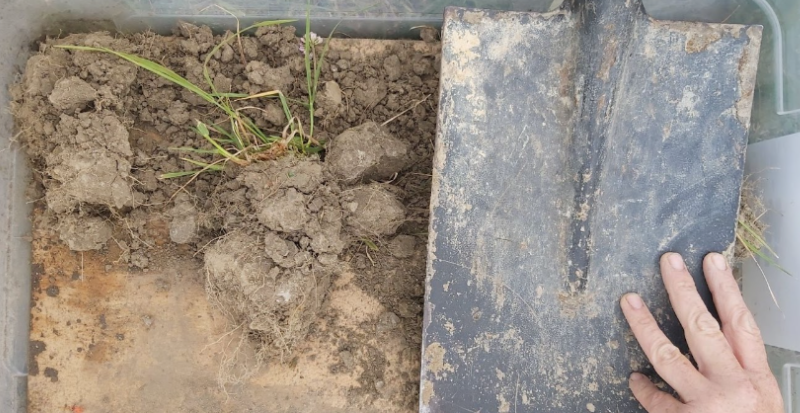
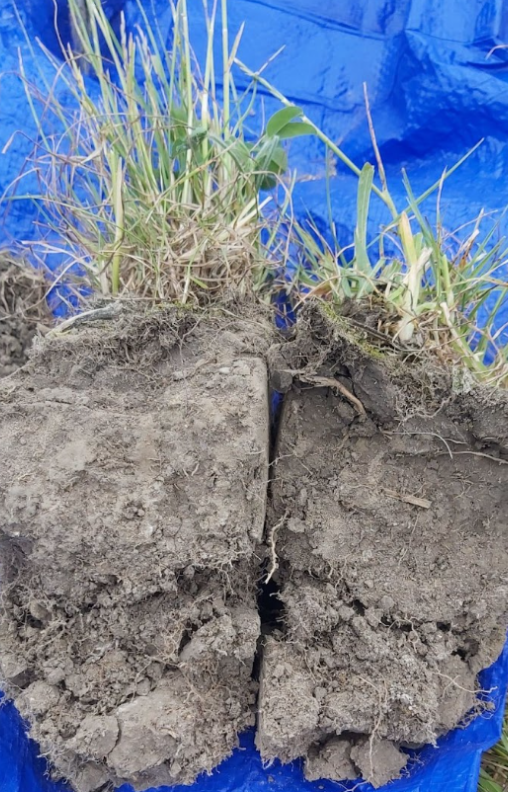
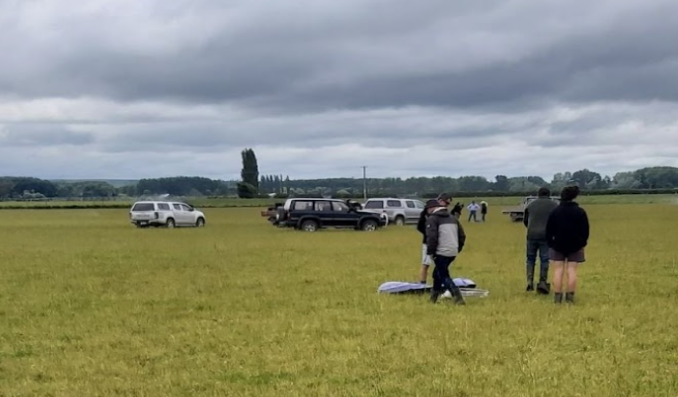
In December 2023, Sam Lang and a group of Catch the Rain farmers held a workshop on James and Brittany’s farm to practice various soil health monitoring techniques and learn about their challenges and goals. The monitoring was undertaken in a paddock that had two years in fodderbeet, including an incredibly wet winter, before being re-grassed the previous spring (spring 2022). The pasture was noticeably struggling and the monitoring exercise also revealed:
This paddock had been recently irrigated with a k-line system yet the soil was visibly dry.
No earthworms could be found
80% of the roots were contained in the top 12cm
The penetrometer (device for measuring compaction) often could not get through the top 10cm
Most Visual Soil Assessment (VSA) scores were 0.5 out of 2.
Infiltration rates showed it took over 30 minutes to infiltrate 1 inch of rain, illustrating a major lack of soil porosity and aggregation.
When digging holes there was also a consistent hard pan at ~25cm.
These observations align with James and Brittany’s observations of inconsistent performance of perennial pastures, following fodderbeet crops. Wet winters are noted to have a large effect on this variability.
The goal for their Catch the Rain trial is to test methods designed to quickly repair soil structure and health to ex-fodderbeet paddocks, to enable better establishment and performance of subsequent perennial pastures.
Trial set up
The trial focuses on a 2024 ex fodderbeet paddock, split into nine different treatments (refer to the end of the article for detailed seed mixes and fertiliser products).
Three seed mixes*:
Normal perennial pasture mix.
Italian ryegrass with oats, vetch and clover varieties.
Diverse annual mix (maize, peas, faba beans, and smaller seeds)
*Seed mixture specifics in green images below
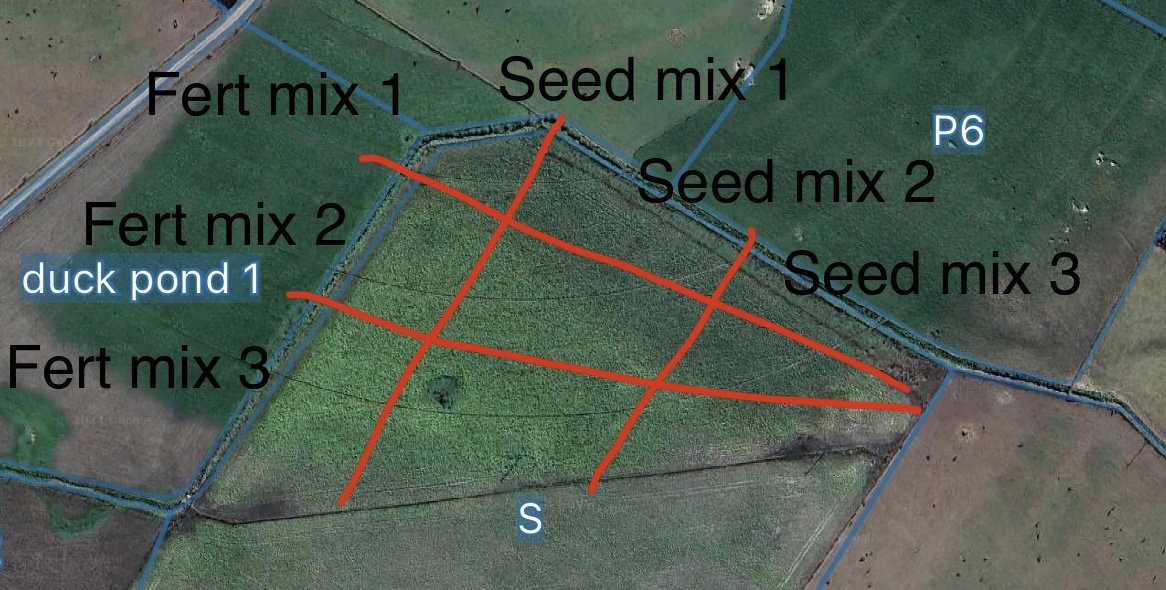
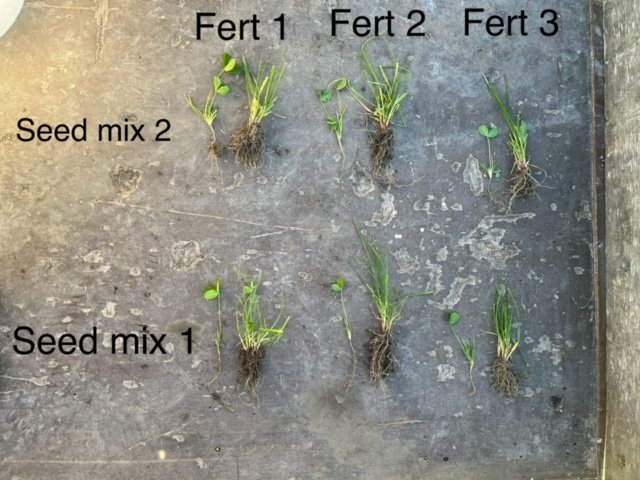
Three fertiliser inputs:
Fertiliser mix 1: None
Fertiliser mix 2: Sulphur90 + SOA
50kg Sulphur 90
150kg Sulphate of Ammonia
31 units nitrogen, 81 units sulphur. Product cost of $113/ha
Fertiliser mix 3: Biologically based fertiliser
232kg/ha
5 units nitrogen, 20 units sulphur, 3.3 units phosphate, 3.3 units potassium. Product cost of $202/ha.
*Both fertiliser mixes were cultivated and incorporated prior to drilling.
The combinations create a 3x3 lattice design to test soil structure and pasture performance under pivot irrigation. The grass mixes were drilled in September with first grazing in November, whereas the annual mix sat fallow for a couple of months before being drilled in November. Further data collection is planned for autumn and subsequent seasons and will include Visual Soil Assessments (soil structure, rooting depth, earthworms etc), infiltration rates, nodulation, rhizosheaths, compaction etc.
Observations
Visual Observations 7 days recovery after first grazing:
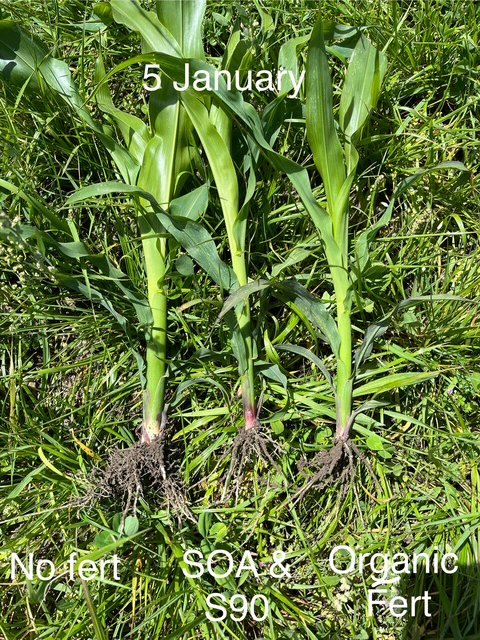
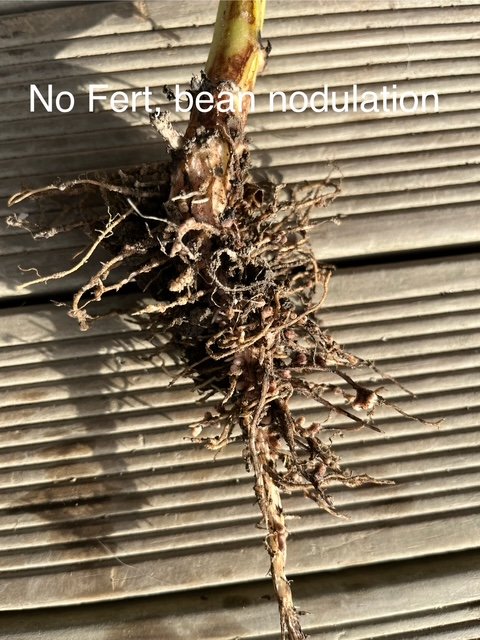
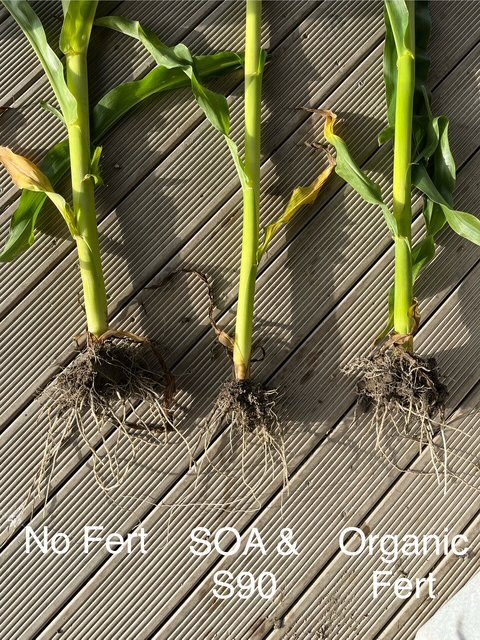
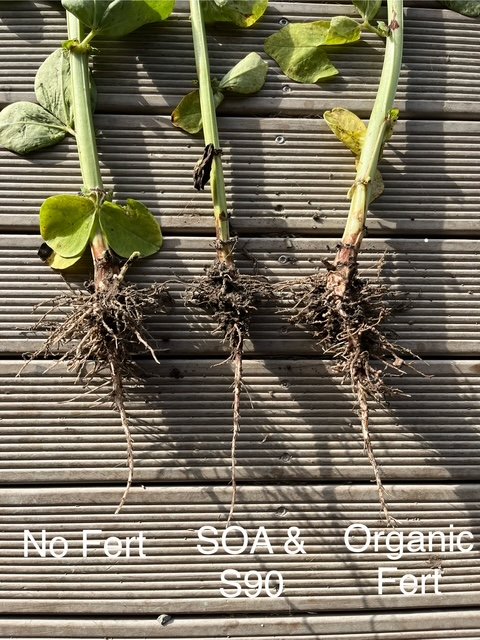
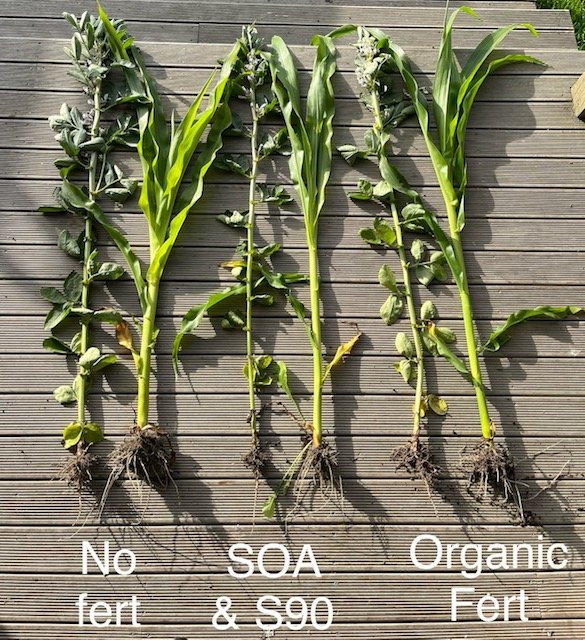
Fertiliser mix 1: None
Has least amount of grass (don't know whether thats because its grown less, or was grazed harder)
Good nodulation on clovers
Ok root development
Greater mix in what species are in pasture, more "weeds"
Fertiliser mix 2: Sulphur90 + SOA
Good root development
Good nodulation on clovers
Soil sticking to roots of ryegrass, soil a darker colour
Few "weeds"
Fert mix 3: Biologically based fertiliser
Good nodulation on clovers
Ok root developement
Few "weeds"
Some exudates or ryegrass roots
Overall comments:
There wasn't a visual difference in the pasture between fertiliser mixes 2 and 3.
No fertiliser pasture had recovered less from grazing.
Fertiliser treatments 1 and 3 had an unobservable difference in root mass or development.
Fertiliser treatment 2 had significantly greater root development, exudates, and a darker colour.
All pastures are growing well and looking healthy
Background: The journey into farming
James studied Environmental Management at Lincoln University but found himself drawn back to the farm after a summer deer farming job. This experience helped him realize he could achieve more working directly on the land than in the regulatory space. Farming offered a way to care for livestock, minimize environmental impact, and plan for future generations.
Farming is a family affair for the Pearse family. James’s parents farm just 10 minutes away on a property settled by their ancestors in 1863, and his brothers are also dairy and deer farmers.
Brittany also studied at Lincoln University, completing a Bachelor of Agricultural Science. Five years ago, Britt started working for independent South Canterbury based agronomy company ‘Turnbull Grain and Seed’.
Growing up just south of Timaru also on her family farm, which were some of the first Turnbull clients 130 years ago. The farming passion was installed early and the want to simply ‘help farmers farm’ is a driving force to her agronomy and farming position.
Balancing environmental and farming values
While their farming approach remains largely conventional on the home farm for now, James acknowledges that some high production practices like fodderbeet create some positives, they also create some challenges. Observing what works and what doesn’t across two different systems is a great opportunity to learn from both and try different ideas in different contexts.
Past experiments, like diverse feed mixes for summer and winter, provided valuable insights but were not well aligned with their system and feed requirements at the time. These experiences highlight James’s approach: informed and cautious, he’s open to adapting and changing his whole system but ensures changes remain commercially viable.
Hopes for the future
James hopes to continue operating a successful, sustainable family farm into the future.
He is happy with the farm system on the whole at the moment, but will continue to change and adapt as opportunities and learnings arise.
Key learnings and influences
Successes to Date: Deferred grazing, larger mob sizes, rotational grazing, and pasture diversification have contributed to farm efficiency and sustainability.
Challenges: Soil compaction, root depths, fertility on the lease block, and the impact of winter cropping.
Influences: James gains insights from a farmer discussion group led by John King, podcasts (like Jono’s), and information distributed by QS.
Looking ahead
The CtR trial offers an opportunity to test and refine new practices and contribute to broader discussions about sustainable farming. James and Brittany remain committed to balancing productivity and environmental stewardship, with an eye on the future.
We’ll be sure to follow up in winter when the autumn monitoring and first seasons results have been collected.
Related content on: marketing, community
Disclaimer: The information, opinions and ideas presented in this content is for information purposes only and does not constitute professional advice. Any reliance on the content provided is done at your own risk. (click here to view full disclaimer).
